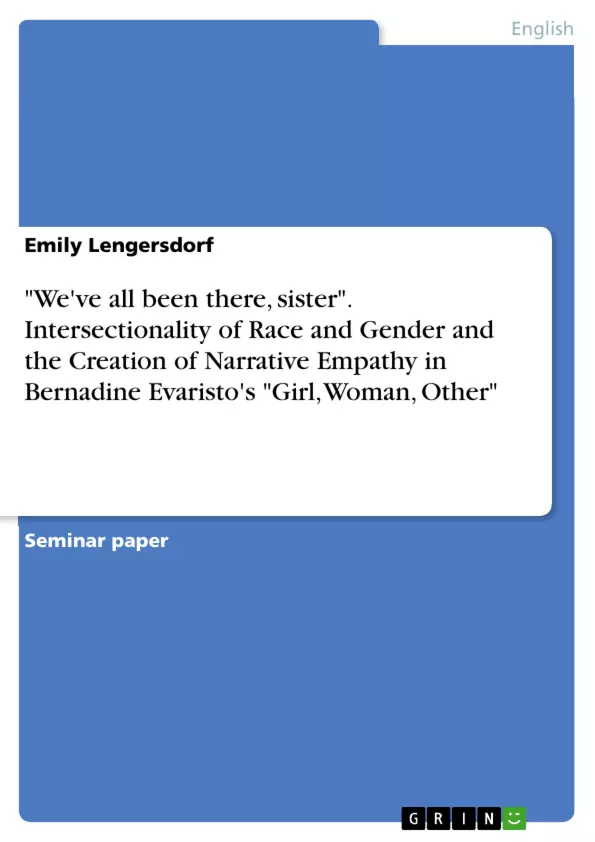The aim of this paper is to examine the themes of racial identity and gender identity, as well as their intersectionality in "Girl, Woman, Other" on the one hand, and the effects of narrative characteristics and fusion fiction in relation to the content of the novel on the other. This also includes figuring out how these features can generate empathy in the reader and the extent to which the novel achieves this.
For this purpose, some of the terms just mentioned will first be defined and a brief summary of the content will be provided, in order that some of the individual experiences of the characters can be analyzed in more detail later. In this context, the concept of 'othering', which is strongly related to oppression, will also be addressed. Later, an analysis of the narrative characteristics of "Girl, Woman, Other" will be carried out and its effects on creating empathy in the reader will be explained.
Inhaltsverzeichnis (Table of Contents)
- Introduction
- Racial and Gender Identity
- Bernadine Evaristo's Girl, Woman, Other
- Explanation of Terms
- Character's Experiences
- Yazz & Amma
- Megan
- The Other
- Creation of Narrative Empathy
- Narrative Situation(s) in Girl, Woman, Other
- Effects of the Narrative Features
- Conclusion
Zielsetzung und Themenschwerpunkte (Objectives and Key Themes)
This paper aims to examine the themes of racial identity and gender identity, as well as their intersectionality in Bernadine Evaristo's novel Girl, Woman, Other. The paper further explores the effects of narrative characteristics and "fusion fiction" in relation to the novel's content and how these features can generate empathy in the reader.
- Racial and Gender Identity and their Intersectional Nature
- The Experiences of Black British Women in Modern British Society
- The Role of Narrative Situation and Fusion Fiction in Conveying Emotion
- The Creation of Narrative Empathy in the Reader
- The Significance of Representation and Visibility of Oppressed Minorities
Zusammenfassung der Kapitel (Chapter Summaries)
The introduction explores the significance of Bernadine Evaristo's Girl, Woman, Other in terms of its contribution to the representation of marginalized voices. The chapter also introduces the concept of "fusion fiction" and explains the novel's focus on exploring the complex experiences of Black British women.
The chapter on racial and gender identity provides definitions of these concepts, highlighting the importance of understanding the intersectionality of these identities and their role in creating systems of oppression. The chapter also delves into the experiences of specific characters within the novel, showcasing the complexities of Black British identities in modern society.
The chapter on the creation of narrative empathy examines the novel's use of different narrative situations and the role of fusion fiction in conveying emotion and fostering empathy in the reader. This section analyzes how the novel's narrative techniques contribute to its overall impact.
Schlüsselwörter (Keywords)
The main keywords and focus topics of the text include racial identity, gender identity, intersectionality, Black British women, fusion fiction, narrative empathy, representation, marginalized voices, and modern British society.
- Citar trabajo
- Emily Lengersdorf (Autor), 2023, "We've all been there, sister". Intersectionality of Race and Gender and the Creation of Narrative Empathy in Bernadine Evaristo's "Girl, Woman, Other", Múnich, GRIN Verlag, https://www.grin.com/document/1485752



